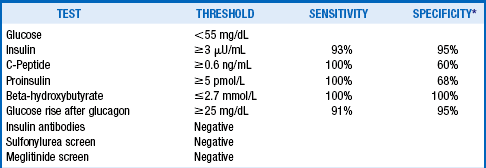Pancreatic endocrine tumors
1. What are the pancreatic endocrine tumors?
Tumors that arise from the islet cells of the pancreas are generally named for the hormones they secrete. These include tumors that secrete insulin (insulinomas), gastrin (gastrinomas), vasoactive intestinal polypeptide (VIPomas), glucagon (glucagonomas), somatostatin (somatostatinomas), pancreatic polypeptide (PPomas), corticotropin-releasing factor (CRFomas), adrenocorticotropic hormone (ACTHomas), and growth hormone–releasing factor (GRFomas) (Fig. 53-1).

Figure 53-1. Pancreatic islet-cell tumors.
2. Are pancreatic endocrine tumors usually benign or malignant?
Insulinomas are usually benign (80%–90%); other pancreatic endocrine tumors are frequently malignant (50%–80%).
3. Are pancreatic endocrine tumors associated with other endocrine disorders?
Multiple endocrine neoplasia type 1 (MEN-1) syndrome accounts for up to 10% of pancreatic endocrine tumors. This inherited disorder consists of pituitary tumors, pancreatic endocrine tumors, and hyperparathyroidism. Hyperparathyroidism usually precedes the pituitary and pancreatic tumors by years. The condition is caused by an inherited mutation in the menin gene.
Insulinomas are discrete insulin-producing tumors within the pancreas. They belong to a larger group of hyperinsulinemic pancreatic beta-cell disorders that include insulinomas, islet-cell hyperplasia, and nesidioblastosis (neoproliferation of beta cells along the pancreatic ducts).
6. What glucose levels are considered to be hypoglycemia?
Glucose levels lower than 55 mg/dL are commonly considered to be hypoglycemic, but the best criteria for hypoglycemia continue to be controversial.
7. What are the symptoms of hypoglycemia?
Hypoglycemic symptoms are classified by their type and timing in relation to meals. Neuroglycopenic symptoms (confusion, slurred speech, blurred vision, seizures, coma) result from inadequate glucose delivery to the brain. Adrenergic symptoms (tremors, sweating, palpitations, nausea) result from catecholamine discharges. Symptoms that occur within 5 hours after a meal are termed postprandial; those occurring more than 5 hours after meals are considered fasting. Neuroglycopenic symptoms are characteristic of insulinomas, but adrenergic symptoms may also occur. Insulinomas most commonly cause fasting hypoglycemia (73%), although both fasting and postprandial hypoglycemia (21%) and pure postprandial hypoglycemia (6%) may be seen.
8. What evaluation should be done to test for an insulinoma?
Blood samples can be obtained during an episode of witnessed hypoglycemia, or the conditions that provoke the hypoglycemia must be replicated. This is most commonly done with a prolonged fast (supervised 72-hour fast or outpatient 12- to 18-hour fast). For this procedure, patients are allowed to drink calorie-free, caffeine-free beverages only. Blood is drawn every 6 hours until the glucose is less than 60 mg/dL, and then every 1 to 2 hours. Sufficient blood is obtained for measurement of glucose, insulin, C-peptide, proinsulin, and beta-hydroxybutyrate; glucose is measured immediately on all samples, and the other tests are run only on samples for which the glucose is lower than 55 mg/dL. Insulin antibodies are ordered on one sample, and a urine screen is sent for sulfonylureas and meglitinides. The test is stopped when the patient has typical symptoms, when the glucose level is less than 45 mg/dL (or <55 mg/dL if Whipple’s triad was previously demonstrated) or at the end of 72 hours. At the end of the test, glucagon 1 mg is given intravenously, and glucose is measured 10, 20, and 30 minutes later.
9. What are the diagnostic criteria for an insulinoma?
Hypoglycemia with endogenous hyperinsulinemia must be demonstrated to diagnose an insulinoma. Diagnostic criteria are shown in Table 53-1.
TABLE 53-1.
DIAGNOSTIC CRITERIA FOR INSULINOMA: DEMONSTRATION OF HYPOGLYCEMIA WITH ENDOGENOUS HYPERINSULINEMIA

*Compared with normal controls who developed glucose <60 mg/dL during a 72-hour fast.
Adapted from Cryer PE, Axelrod L, Grossman AB, et al: Evaluation and management of adult hypoglycemic disorders: an Endocrine Society Clinical Practice Guideline. J Clin Endocrinol Metab 94:709–728, 2009; and KA Placzkowski, A Vella, GB Thompson, et al: Secular trends in the presentation and management of functioning insulinoma at the Mayo Clinic, 1987–2007. J Clin Endocrinol Metab 94:1069–1073, 2009.
10. How can an insulinoma be localized?




